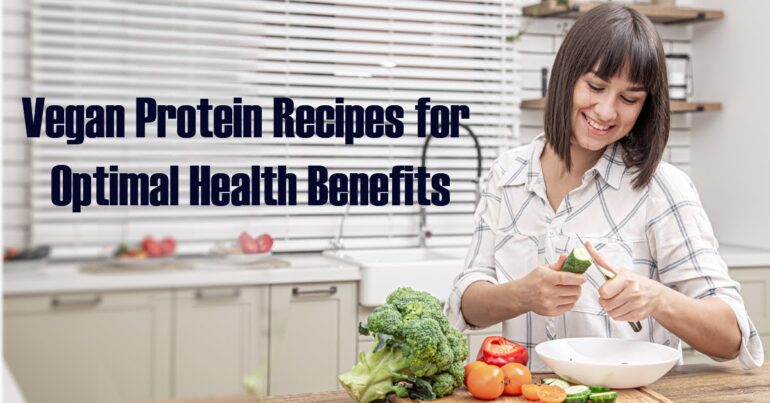Many people believe that a protein-rich diet must include animal products. However, vegan protein sources can offer significant health benefits and are often packed with nutrients. This article provides delicious vegan protein recipes that not only meet dietary needs but also enhance overall wellness. Readers will discover a protein-packed quinoa salad, a hearty chickpea and spinach stew, and several other satisfying meals. By exploring these recipes, readers can overcome challenges related to protein intake while enjoying flavorful, health-boosting dishes.
Key Takeaways
- Plant-based proteins support muscle recovery and overall well-being
- Recipes like quinoa salad provide vital nutrients for a balanced diet
- Chickpeas and spinach are nutrient-rich ingredients for hearty vegan meals
- Incorporating diverse ingredients enhances flavor and health benefits in meals
- High-protein snacks like energy balls are convenient and nutritious options
Benefits of Incorporating Vegan Protein Into Your Diet
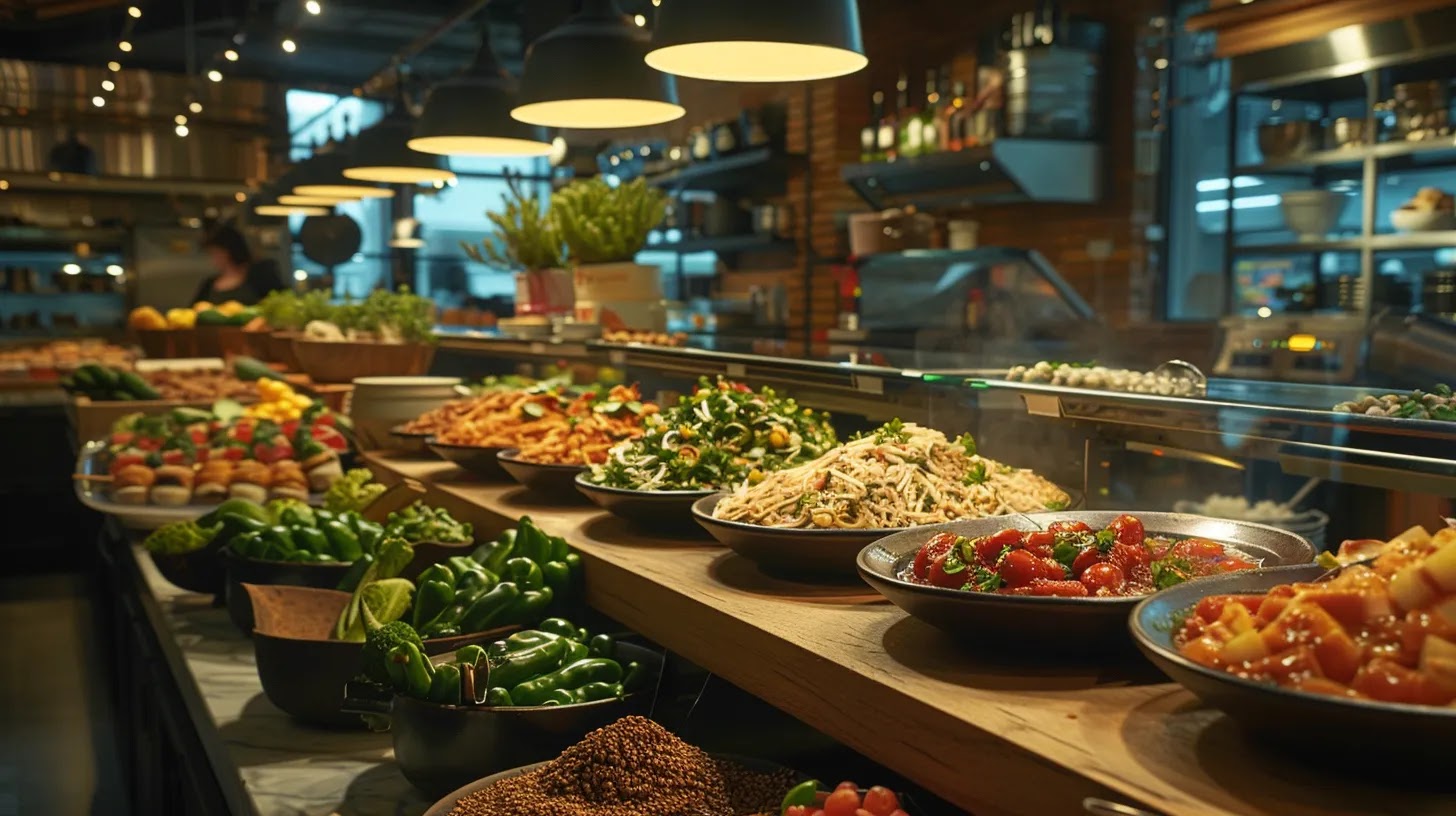
Plant-based proteins, such as those found in sesame, jalapeño, and peanut butter recipes, offer significant health advantages. Incorporating these proteins into one’s diet can enhance muscle recovery, support heart health, and improve overall well-being, as suggested by dietitians. This section will provide insights into the benefits of vegan proteins and share delicious vegan stew recipes to maximize health benefits.
Understanding Plant-Based Proteins
Plant-based proteins, such as tempeh and wheat, provide a rich source of essential nutrients and amino acids, making them suitable alternatives to traditional protein sources like ground meat. These proteins are often rich in umami flavors, enhancing the overall taste of meals, especially in healthy tofu recipes for dinner. Integrating these options into daily meals not only supports muscle recovery but also promotes overall health and well-being.
Health Advantages of Vegan Proteins
Vegan proteins offer multiple health advantages, particularly in reducing inflammation and managing saturated fat intake. Plant-based options like cabbage, along with protein powders and flours made from legumes and grains, are not only nutritious but also aid in maintaining a balanced diet. By incorporating these ingredients into meals, individuals can promote muscle recovery and overall wellness while enjoying delicious, low-fat recipes.
Vegan protein can fuel your body well. Next, a satisfying protein-packed quinoa salad awaits to nourish not just your hunger, but your spirit.
Meal #1: Protein-Packed Quinoa Salad
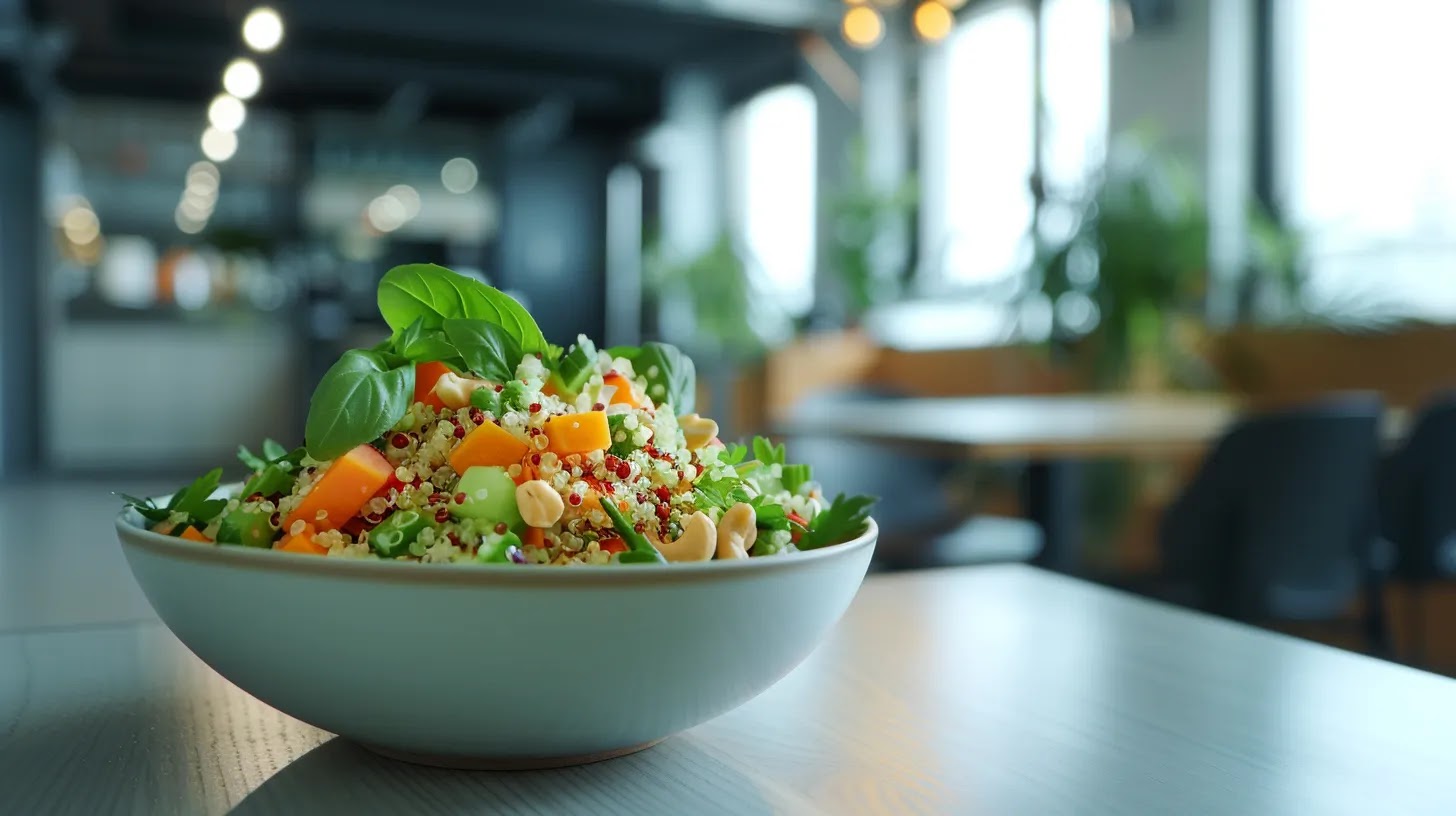
This protein-packed quinoa salad features key ingredients that boost protein content, such as cashew nuts and flax seeds. The following step-by-step preparation guide outlines how to create this nutritious dish, rounding out its health benefits. Nutritional information will be provided to highlight the salad’s contributions to a balanced vegan cuisine. This recipe serves as a delicious option for those seeking a protein ball recipe vegan while promoting overall health.
Key Ingredients That Boost Protein Content
Key ingredients that boost the protein content of a quinoa salad include cashew nuts, flax seeds, and spices like cumin. Cashew nuts not only contribute healthy monounsaturated fat but also enhance the overall flavor while providing essential nutrients such as potassium. Adding vegetable broth to the mix infuses additional richness, ensuring this protein-packed option serves as a fulfilling breakfast vegan protein source for individuals seeking to improve their health through plant-based eating:
| Ingredient | Protein (grams) | Benefits |
|---|---|---|
| Quinoa (1 cup cooked) | 8 | Complete protein source |
| Cashew Nuts (1 oz) | 5 | Rich in monounsaturated fat |
| Flax Seeds (1 tbsp) | 2 | High in omega-3 fatty acids |
| Cumin (1 tsp) | 0.6 | Adds flavor and digestive benefits |
Step-by-Step Preparation Guide
To prepare a protein-packed quinoa salad, begin by rinsing one cup of quinoa under cold water to remove any bitterness. Next, cook the quinoa in two cups of vegetable broth for about 15 minutes until fluffy. While the quinoa cooks, chop up veggies of choice and toast some cashew nuts for added crunch and flavor. After mixing the quinoa with the veggies, sprinkle flax seeds for a boost of vitamin E and nutrients. For an added layer of taste, a dollop of cream made from blended peanuts can be served on the side or drizzled over the salad, enhancing both richness and health benefits.
- Rinse quinoa to remove bitterness.
- Cook quinoa in vegetable broth.
- Chop veggies and toast cashew nuts.
- Mix ingredients with flax seeds for nutrients.
- Serve with peanut cream for added flavor.
Nutritional Information
The nutritional profile of the protein-packed quinoa salad highlights its numerous health benefits. This dish serves as an excellent source of grain, providing a complete protein that includes essential amino acids. Additionally, the incorporation of spices such as crushed red pepper not only enhances flavor but also supports metabolism, while the salad’s inclusion of vegetables ensures a rich supply of vitamins, including folate, which is vital for cellular health. The low sugar content contributes to stable energy levels, making this meal an optimal choice for anyone seeking to improve their diet.
- Quinoa provides a complete protein source and is rich in essential nutrients.
- Spices like crushed red pepper add flavor and boost metabolism.
- Includes vegetables that offer vital vitamins, such as folate.
- Low sugar content helps maintain stable energy throughout the day.
After the refreshing taste of the quinoa salad, a warm stew beckons. The rich flavors of chickpeas and spinach promise comfort and nourishment for the next meal.
Meal #2: Chickpea and Spinach Stew
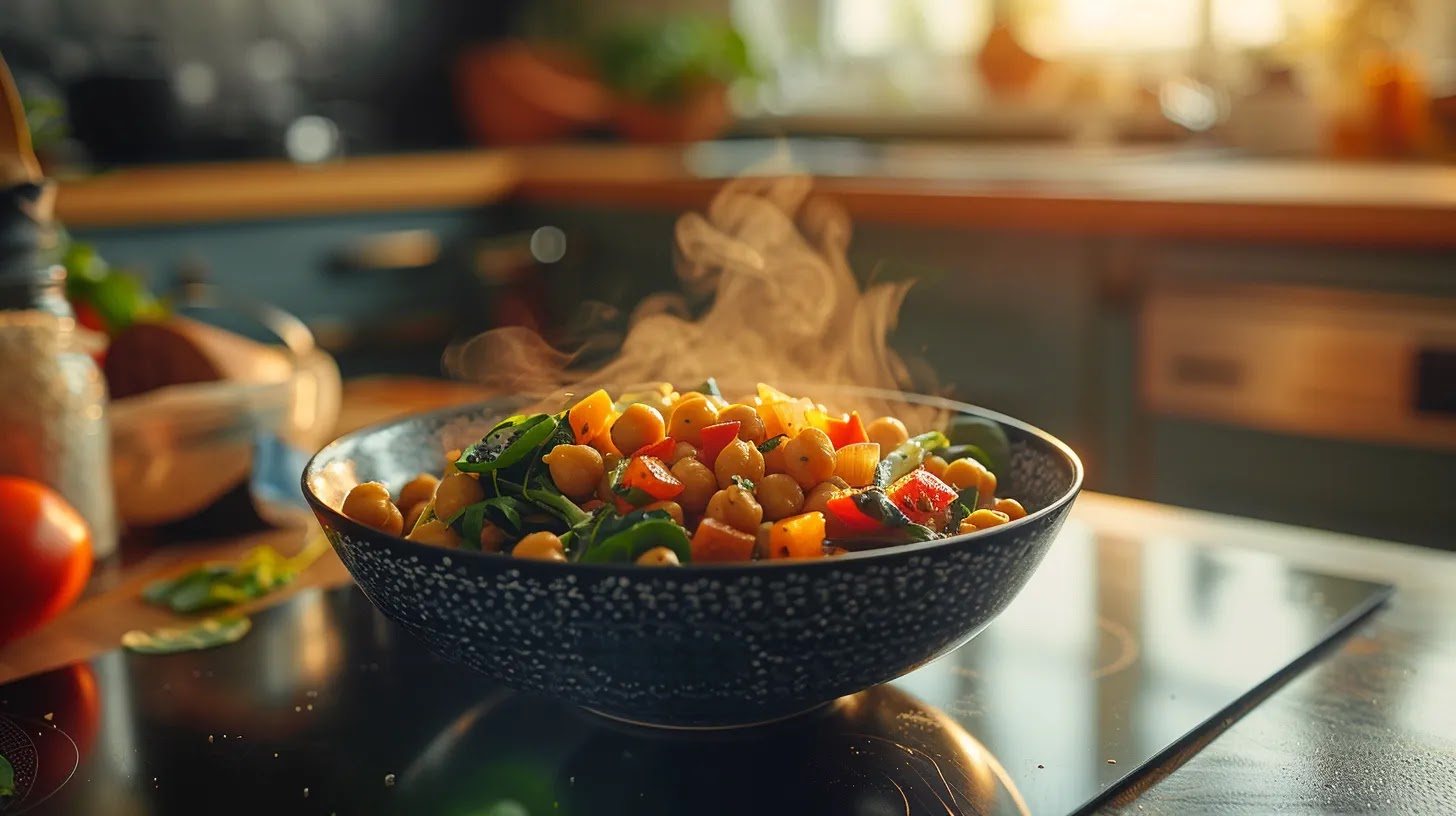
This chickpea and spinach stew stands out as a nutritional powerhouse due to its rich combination of plant-based proteins, vitamins, and minerals. Cooking instructions include the effective use of rice vinegar and nutritional yeast to enhance flavor, while stir frying bell peppers provides added texture and taste. The health benefits of chickpeas and spinach make this dish an excellent choice for those looking to boost their overall wellness.
Why This Dish Is a Nutritional Powerhouse
The chickpea and spinach stew serves as a nutritional powerhouse due to its rich content of antioxidants and plant-based proteins, which contribute to increased energy levels and overall vitality. This dish boasts the inclusion of chickpeas, known for their protein density that rivals cottage cheese, while spinach provides essential vitamins and minerals that support health. Cooking the stew in an oven allows the ingredients to meld together perfectly, enhancing flavor while maintaining health benefits, providing a satisfying meal that addresses energy needs effectively.
Cooking Instructions for the Best Flavor
To achieve the best flavor in the chickpea and spinach stew, begin by sautéing minced garlic in a touch of olive oil, as it enhances the aromatic foundation of the dish. Adding in refried beans can provide a creamy texture and additional carbohydrates, making the stew heartier. For a unique twist, consider stirring in a spoonful of pesto, which complements the chickpeas perfectly and elevates the overall mouthfeel of this nourishing meal:
| Ingredient | Flavor Enhancement Technique |
|---|---|
| Garlic | Sauté in olive oil |
| Refried Beans | Add for creaminess and carbohydrates |
| Pesto | Stir in for added depth of flavor |
Health Benefits of Chickpeas and Spinach
Chickpeas and spinach are a dynamic combination that offers numerous health benefits, making them an excellent choice for a wholesome meal. Chickpeas are rich in protein and fiber, which aid in digestion and can function as a hearty side dish or even a satisfying base for a dipping sauce. Meanwhile, spinach provides essential vitamins and minerals while being low in calories, allowing individuals to enjoy this nutritious stew without the added dairy, perfect for those following a vegan diet. This stew serves as a great addition to any cookbook focused on promoting optimal health through plant-based meals.
The warmth of the stew lingered, filling the kitchen with a sense of comfort. Next, a hearty lentil and brown rice bowl awaited, promising both nourishment and satisfaction.
Meal #3: Lentil and Brown Rice Bowl
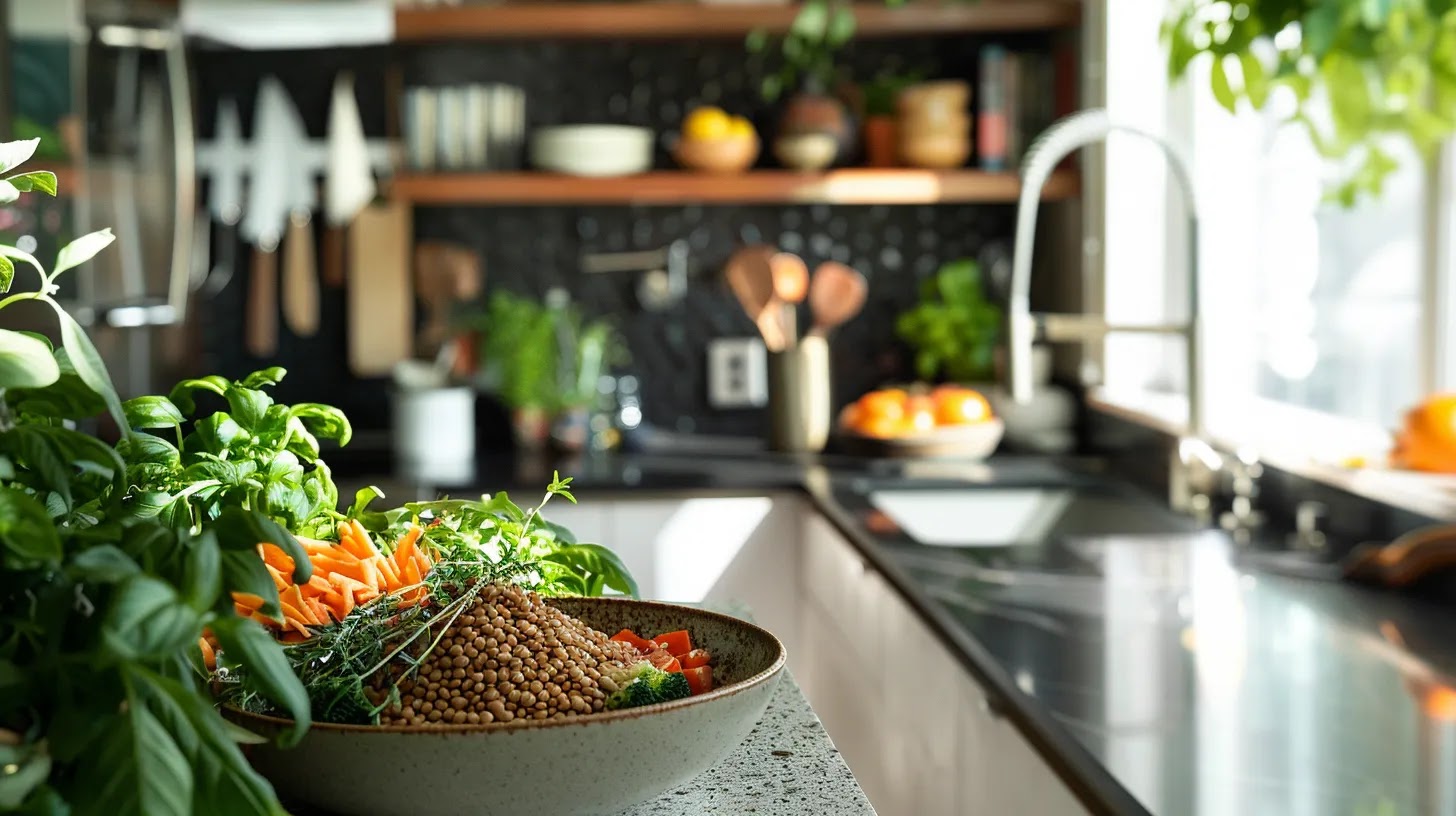
The lentil and brown rice bowl is a nutrient-dense meal that features ingredients rich in protein and fiber, making it an excellent choice for those seeking healthy vegan products. This recipe utilizes a simple cooking method for quick preparation, ensuring delicious results without much effort. Nutritional insights will highlight how pairing lentils with brown rice enhances the benefits of plant-based eating, providing a satisfying base for a variety of dishes, from vegan protein balls to wholesome bean salad.
Ingredients Rich in Protein and Fiber
The lentil and brown rice bowl can be enhanced by incorporating ingredients rich in protein and fiber, such as cauliflower and soy milk. Cauliflower not only provides additional nutrients and fiber but also serves as a versatile base ingredient that can be roasted or steamed to bring out its natural flavors. Additionally, including a teaspoon of zinc-rich spices can help promote immune function and overall health, making this dish both satisfying and nourishing.
| Ingredient | Protein (grams) | Fiber (grams) | Additional Benefits |
|---|---|---|---|
| Lentils (1 cup cooked) | 18 | 15.6 | High in protein and fiber |
| Brown Rice (1 cup cooked) | 5 | 3.5 | Whole grain source |
| Cauliflower (1 cup raw) | 2 | 2 | Rich in vitamins C and K |
| Soy Milk (1 cup) | 7 | 1 | Source of calcium and vitamin D |
Simple Cooking Method for Quick Meals
Preparing a lentil and brown rice bowl can be a quick and straightforward process that suits those seeking a nutritious meal. Using mycoprotein as a meat alternative enhances the dish‘s texture while contributing valuable dietary fiber. To add flavor, a homemade sauce made from blended seeds, such as sunflower or pumpkin, can elevate the bowl without introducing common food allergens like dairy or gluten. This meal not only provides essential nutrients but also caters to diverse dietary needs, making it a practical choice for anyone aiming for optimal health benefits.
Nutritional Insights
The lentil and brown rice bowl is a nutrient-dense meal that provides significant health benefits, especially in terms of calcium and fiber content. Incorporating ingredients like coconut milk and nuts not only enhances the flavor but also adds healthy fats, contributing to overall well-being. Utilizing a food processor can streamline meal preparation, making it easier to create a wholesome sauce that complements the dish without sacrificing essential nutrients. This bowl is a practical choice for those seeking to boost their plant-based diet while ensuring they meet their nutritional needs.
The lentil and brown rice bowl filled the stomach well, offering comfort and sustenance. Next came the tofu stir-fry with broccoli, promising a vibrant crunch and a burst of flavor that would awaken the senses.
Meal #4: Tofu Stir-Fry With Broccoli

Tofu serves as a versatile protein source, fitting seamlessly into a variety of dishes while supporting a balanced diet. This section will detail preparation methods for achieving maximum nutrition in stir-fry recipes, focusing on effective cooking techniques such as roasting. Additionally, the health benefits of broccoli and other vegetables will be explored, highlighting their low calorie count and contributions to overall wellness. Those who appreciate flavors like lemon and teriyaki will find valuable insights for enhancing their meals.
Tofu as a Versatile Protein Source
Tofu stands out as a versatile protein source, rich in essential nutrients that enhance overall health. It can be easily incorporated into various dishes, including a tofu stir-fry with broccoli, by pairing it with wild rice or sweet potatoes for added texture and flavor. Utilizing olive oil in the cooking process not only contributes healthy fats but also aids in the absorption of B vitamins from the vegetables, making this dish a nutritious option that supports a balanced vegan diet.
Preparing the Stir-Fry for Maximum Nutrition
Preparing a tofu stir-fry with broccoli not only delivers a satisfying meal but also optimizes nutrition with the right techniques. Utilizing almond milk as a cooking liquid can enhance the dish‘s creaminess while providing essential nutrients such as manganese and contributing to a healthy diet. For a complete protein source, pairing tofu with broccoli and incorporating grains like quinoa ensures that individuals receive all essential amino acids, supporting their nutritional needs effectively.
| Ingredient | Nutritional Benefit |
|---|---|
| Tofu | Complete protein source, rich in calcium |
| Broccoli | High in vitamins K and C, good source of manganese |
| Almond Milk | Low in calories, contains vitamin E and healthy fats |
| Quinoa | Complete protein, high in fiber and minerals |
Benefits of Broccoli and Other Vegetables
Broccoli and other vegetables play a vital role in a balanced diet, as they are rich in vitamins, minerals, and antioxidants, supporting overall health. Incorporating ingredients like broccoli and onion in meals can enhance nutritional value while providing essential nutrients that are sometimes lacking in diets heavy on beef or other animal products. According to the Academy of Nutrition and Dietetics, vegetables contribute to better digestion and can lower cholesterol levels, making them a powerful component in plant-based recipes that aim to maximize health benefits.
- Broccoli provides essential vitamins such as K and C.
- Onion adds flavor and beneficial compounds that support gut health.
- Combining tofu and vegetables creates a complete protein source.
- Using yeast as a seasoning can enhance flavor without extra calories.
After a hearty meal, snacks come calling. Discover clever ways to incorporate vegan protein into your bites, turning simple treats into powerful fuel.
Creative Ways to Use Vegan Protein in Snacks
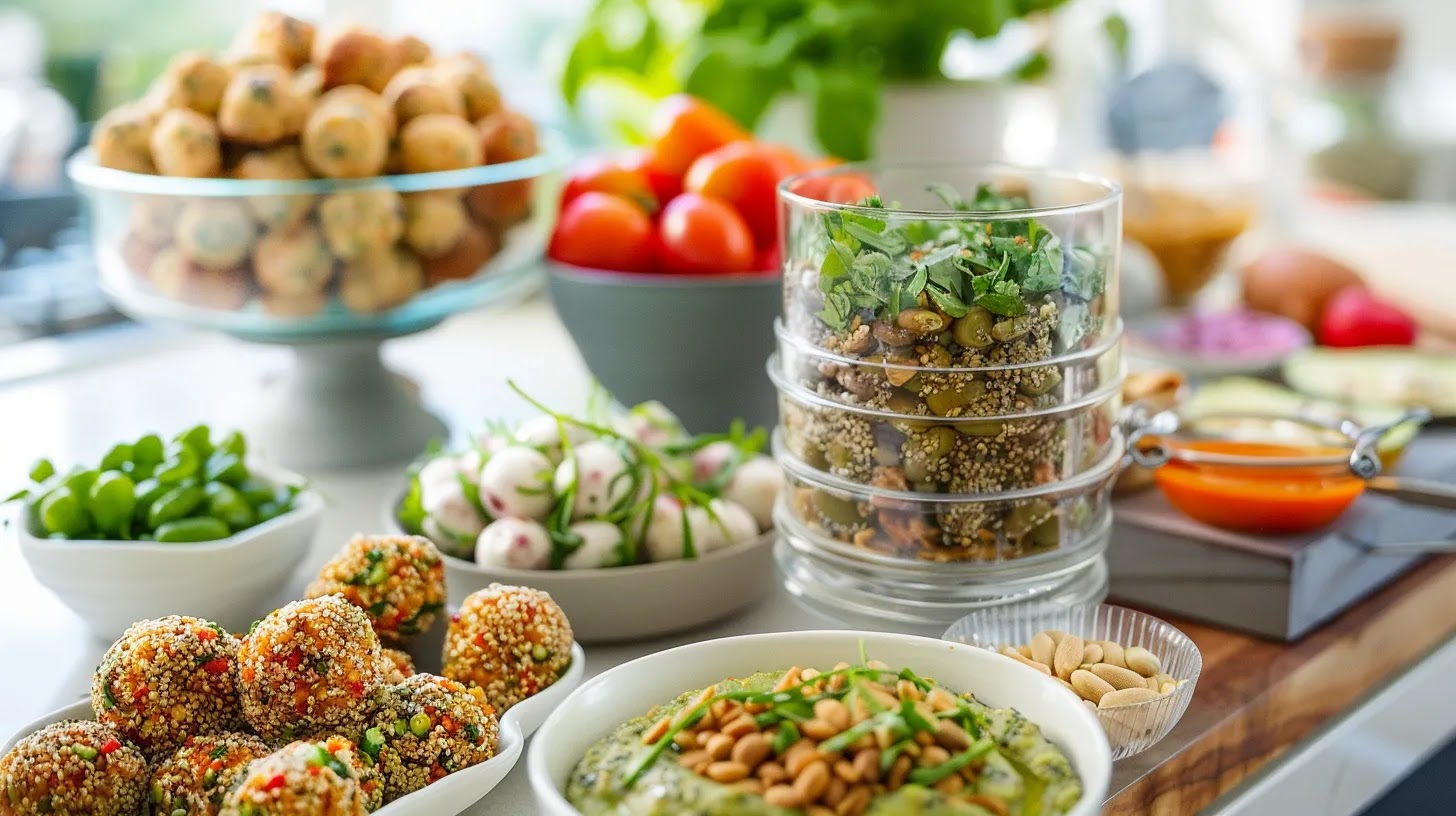
High-protein smoothies are a versatile option that can incorporate ingredients like lentils and a blend of nuts and seeds, providing essential lysine and nutrients. Energy balls made with nuts and seeds deliver a convenient, nutritious snack full of energy. Flavorful hummus variations with spices like coriander and a splash of balsamic vinegar offer delicious dips that replace traditional meat-based options, enhancing snack time with plant-based goodness.
High-Protein Smoothie Recipes
High-protein smoothies provide an effective way to incorporate vegan protein into daily routines. Using ingredients like oats, plant milk, and fresh lime juice, these smoothies can be both nutritious and refreshing. Adding mashed potato offers a unique texture while boosting the protein content, making for a satisfying drink that supports overall health and helps prevent diseases related to inadequate nutrition.
- Incorporate oats for fiber and protein.
- Utilize plant milk as a base for added nutrients.
- Include lime for a zesty flavor boost.
- Add mashed potato for texture and enhanced protein.
- Focus on nutrient balance to support health.
Energy Balls With Nuts and Seeds
Energy balls made with nuts and seeds are an excellent snack option for those looking to incorporate vegan dishes with protein into their diet. Packed with nutrients, these energy bites can include ingredients like brown rice, which enhances their protein and fiber content while keeping sodium levels low. By combining nuts, seeds, and optional flavors or sweeteners, individuals can easily create a versatile snack that supports their health and satisfies cravings:
| Ingredient | Nutritional Benefit |
|---|---|
| Nuts (e.g., almonds, walnuts) | High in healthy fats and protein |
| Seeds (e.g., chia, flax) | Rich in omega-3 fatty acids and fiber |
| Brown Rice | Source of plant-based protein and carbohydrates |
| Natural Sweetener (e.g., maple syrup) | Adds flavor without refined sugars |
Flavorful Hummus Variations for Dipping
Flavorful hummus variations can transform a simple dish into a nutrient-rich option for dipping. By adding ingredients like black pepper for a subtle kick or blending in roasted red peppers for a smoky taste, one can significantly enhance the nutrition and appeal of the hummus. Experimenting with spices and vegetables not only diversifies the flavor but also ensures that the dish remains a health-conscious choice, making it perfect for anyone looking to enrich their plant-based diet.
- Incorporate black pepper to enhance taste.
- Add roasted red peppers for a smoky flavor.
- Mix in garlic or herbs for extra nutrition.
- Serve with fresh vegetables for a wholesome snack.
Conclusion
Incorporating vegan protein recipes into one’s diet plays a crucial role in achieving optimal health benefits. These recipes, rich in essential nutrients and amino acids, facilitate muscle recovery, enhance energy levels, and support overall wellness. By choosing plant-based options, individuals not only nourish their bodies but also promote sustainable eating habits. Embracing these meals leads to significant improvements in both physical health and dietary balance.


